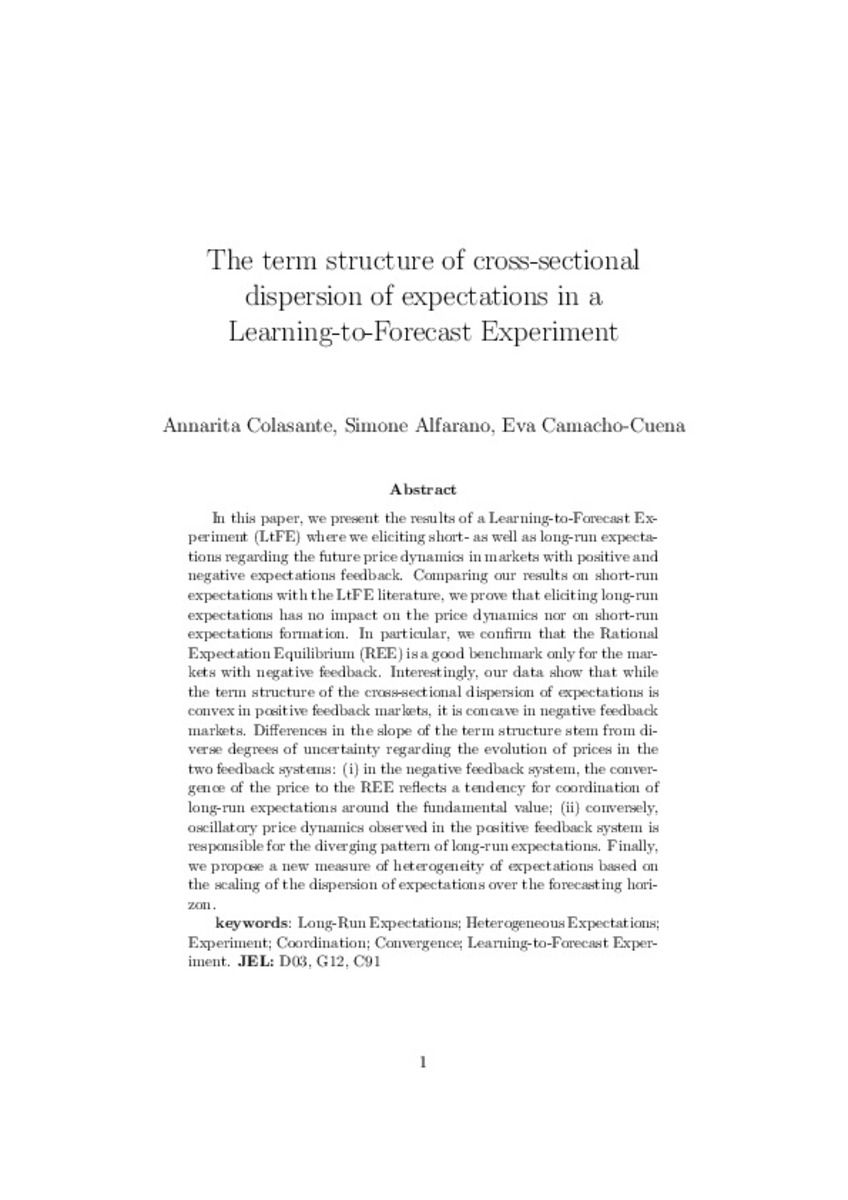Mostrar el registro sencillo del ítem
The term structure of cross-sectional dispersion of expectations in a Learning-to-Forecast Experiment
| dc.contributor.author | Colasante, Annarita | |
| dc.contributor.author | Alfarano, Simone | |
| dc.contributor.author | Camacho Cuena, Eva | |
| dc.date.accessioned | 2019-05-17T09:37:48Z | |
| dc.date.available | 2019-05-17T09:37:48Z | |
| dc.date.issued | 2019-03-09 | |
| dc.identifier.citation | Colasante, A., Alfarano, S. & Camacho-Cuena, E. J Econ Interact Coord (2019). https://doi.org/10.1007/s11403-019-00245-6 | ca_CA |
| dc.identifier.uri | http://hdl.handle.net/10234/182521 | |
| dc.description.abstract | In this paper, we present the results of a Learning-to-Forecast Experiment (LtFE) where we eliciting short- as well as long-run expectations regarding the future price dynamics in markets with positive and negative expectations feedback. Comparing our results on short-run expectations with the LtFE literature, we prove that eliciting long-run expectations has no impact on the price dynamics nor on short-run expectations formation. In particular, we confirm that the Rational Expectation Equilibrium (REE) is a good benchmark only for the markets with negative feedback. Interestingly, our data show that while the term structure of the cross-sectional dispersion of expectations is convex in positive feedback markets, it is concave in negative feedback markets. Differences in the slope of the term structure stem from diverse degrees of uncertainty regarding the evolution of prices in the two feedback systems: (1) in the negative feedback system, the convergence of the price to the REE reflects a tendency for coordination of long-run expectations around the fundamental value; (2) conversely, oscillatory price dynamics observed in the positive feedback system is responsible for the diverging pattern of long-run expectations. Finally, we propose a new measure of heterogeneity of expectations based on the scaling of the dispersion of expectations over the forecasting horizon. | ca_CA |
| dc.format.extent | 30 p. | ca_CA |
| dc.format.mimetype | application/pdf | ca_CA |
| dc.language.iso | eng | ca_CA |
| dc.publisher | Springer | ca_CA |
| dc.rights | © Springer-Verlag GmbH Germany, part of Springer Nature 2019 | ca_CA |
| dc.rights.uri | http://rightsstatements.org/vocab/InC/1.0/ | * |
| dc.subject | long-run expectations | ca_CA |
| dc.subject | heterogeneous expectations | ca_CA |
| dc.subject | experiment | ca_CA |
| dc.subject | coordination | ca_CA |
| dc.subject | convergence | ca_CA |
| dc.subject | Learning-to-Forecast Experiment | ca_CA |
| dc.title | The term structure of cross-sectional dispersion of expectations in a Learning-to-Forecast Experiment | ca_CA |
| dc.type | info:eu-repo/semantics/article | ca_CA |
| dc.identifier.doi | https://doi.org/10.1007/s11403-019-00245-6 | |
| dc.relation.projectID | Universitat Jaume I (Project P11B2015-63) ; Spanish Ministry of Science and Technology (Project ECO2015-68469-R) ; Valencian Regional Government (Project AICO/2018/036) | ca_CA |
| dc.rights.accessRights | info:eu-repo/semantics/openAccess | ca_CA |
| dc.relation.publisherVersion | https://link.springer.com/article/10.1007/s11403-019-00245-6#enumeration | ca_CA |
| dc.date.embargoEndDate | 2020-03-09 | |
| dc.type.version | info:eu-repo/semantics/acceptedVersion | ca_CA |
Ficheros en el ítem
Este ítem aparece en la(s) siguiente(s) colección(ones)
-
ECO_Articles [693]







